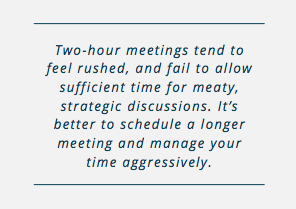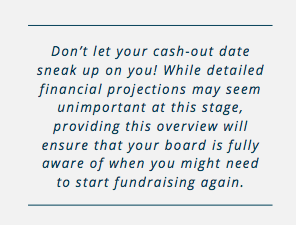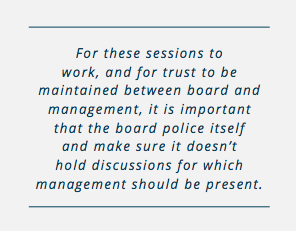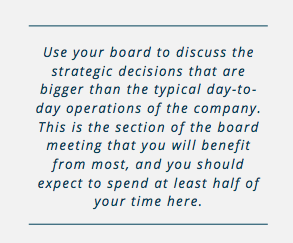So you’ve brought on institutional capital for the first time, agreed to a board structure in the legal docs, and now you have directors that must be kept up to speed on your company (and who get to have a say in the way that you run things). So what’s next?
One of the typical first steps is implementing the dreaded board meeting. First off, take a deep breath and relax… Remember that your board of directors is on your side. Your investors want to see your company succeed as much as you do, and they can be a valuable resource to you. With that in mind, a board meeting should be treated as a regular check-in (but probably shouldn’t be your only contact) with people who want to help execute your vision. You should approach the meeting as an opportunity to take advantage of the knowledge and experience of a group of people that can be very helpful to you in working through big strategic issues.
The boardroom should be a place to celebrate your wins, but it should also be a place to work through your problems. Your investors have likely encountered many of the problems that you are facing, and you should use this time to be open and pick their brain about your most pressing issues.
While there is no “one size fits all” board meeting template, we’ve assembled some best practices for seed-stage companies that will serve as a great starting point. We hope you find this to be a helpful resource as you establish the best way of working with your board and extracting as much value out of the brilliant minds around you.
CLICK HERE TO SEE THE STEP-BY-STEP GUIDE TO CONDUCTING A PROPER STARTUP BOARD MEETING
MEETING LOGISTICS
LOCATION
- Don’t be afraid to make your board members come to you. At Primary, we actually prefer onsite board meetings at the company. Here’s why:
 On-site meetings allow senior members of the team to drop in for specific sections and talk directly about their work and progress. This is a great opportunity for these team members to step back from their day-to-day role, be thoughtful about how to present their work, and feel like they are making valuable contributions to the company.
On-site meetings allow senior members of the team to drop in for specific sections and talk directly about their work and progress. This is a great opportunity for these team members to step back from their day-to-day role, be thoughtful about how to present their work, and feel like they are making valuable contributions to the company.- On-site meetings allow board members to get to know the broader team at the company, recognize familiar faces, and generally increase their connection with the company.
- If you don’t have the space to hold a board meeting on site, ask your investors. Most VCs have conference room facilities available (which are generally conveniently located), and are happy to offer these up for your use.
- If you are not holding your board meeting on site, confirm in advance the equipment that will be available for use in your reserved space. This is particularly important if you plan to show a demo during the meeting, or if you have board members joining by phone or video conference.
PREPARATION
- Don’t kill yourself to create a beautiful presentation. We know that you’re probably trying to manage a million things, and your time should definitely be spent on high-priority issues for the business, rather than refining your PowerPoint skills.
- That said, don’t skimp on the information you provide. For example, if you want to talk about your sales pipeline during the board meeting, make sure your current pipeline is in your deck, even if it’s just a Salesforce or Excel screenshot.
- Once you’ve pulled together your presentation, distribute the materials in advance of the meeting. If you give your board some time to review and prepare for the meeting, the meeting itself will be far more productive.
- At Primary, we like to see board decks at least one full day in advance of the meeting. To be clear, we mean one full calendar day (i.e., sending by Tuesday evening for a Thursday morning board meeting). This may not always be possible, but it should always be the goal, and your investors will appreciate the preparation time.
- Post-board meeting, it can also be helpful to send out a summary of the discussion and any important to-dos within a couple of days (see “Topic 7: Wrap-up” in the Suggested Agenda to follow).
TIMING
- Schedule 2-3 hours for a typical board meeting. Note that more board members/observers typically lead to longer meetings.
- As a rule, we find that 2-hour meetings tend to feel rushed, and fail to allow sufficient time for the meaty, strategic discussions that should form the basis of your board meetings.
- In planning meetings, it’s better to schedule a longer meeting, and then manage the agenda aggressively so as not to use all of the allotted time.
- Set a regular cadence for board meetings and schedule them far in advance.
- For early-stage companies, a 6- to 8-week schedule seems to work best. Quarterly meetings for seed companies are way too infrequent, but can work if there are other sorts of interim structural checkpoints.
- One model we’ve found effective is a “formal” quarterly meeting followed by a mid-quarter, more casual meeting that can focus on a handful of hot-button, timely issues
SUGGESTED AGENDA
TOPIC 1: BOARD BUSINESS
- Get the boring stuff out the way first. This can include any formal approvals required by the board, sign-off of previous board meeting minutes, as well as sign-off on option grants for new hires/promotions
- When asking for approval of new option grants, include all of the information the board needs to make a decision, not just the number of options. This means translating specific option grants into a percentage of fully diluted shares, as well as keeping a running tally of how much of the total option pool has been allocated, and how much remains for future employees.
TOPIC 2: ORGANIZATION
- In the beginning of your presentation, it’s always good to show an org chart that includes everyone at the company. Remember that your board members probably sit on a number of boards, so this can be a useful visual that can be referenced in later discussions.
- On the org chart, include open positions that you are currently hiring for, as well as contemplated future hires that are not yet in active recruitment mode.
- Color code the org chart to clearly distinguish new hires, open positions, and existing employees.
 TOPIC 3: FINANCIALS AND KEY METRICS
TOPIC 3: FINANCIALS AND KEY METRICS
- Always provide a quick run-through of your financials in the beginning of the meeting.
- For early-stage companies, burn-rate is key. Tell your board exactly how much cash you burned last month and on average over the past three months.
- At every board meeting, report on how many months of runway you have left in the following two scenarios:
- Assuming no revenue in the company and maintaining your current operating expense. (Note: If you have some guaranteed, recurring revenue, include that, but not any growth.) If there are imminent hires or expenses that you know you must make, include them here.
- A conservative plan of potential revenue growth (i.e., achievable rather than aspirational), offset by any growth in hiring/other costs that are projected in your current plan.
- For financials, report actuals versus plan. Reporting actuals in a vacuum isn’t much help to your board. Of course, seed-stage plans are frequently missed by a mile, even by great companies, as the forecasting process at this stage is extremely difficult and largely based on guesswork. But you should still have a reference point. And if a few months into a year you realize everything has changed, rework your forecast. What’s important is making sure you have clear goals that you’re working toward, and that your team and your board very clearly understand.
- While detailed financial projections may seem unimportant at this stage, providing this overview will ensure that your board is fully aware of when you might need to start fundraising again, and it can help them advise you accordingly. Don’t let your cash-out date sneak up on you!
- When speaking about financials, you should also review the key operating metrics that you are actively tracking.
- What are the metrics that you and your management team focus on together?
- What are they key predictive metrics that help create visibility into the health of the business one or two quarters ahead?
- What are the metrics you track to monitor the underlying unit economics of your business? These might include cost of sales, customer LTV, gross margin, support and customer success expenses, and others.
TOPIC 4: FUNCTIONAL UPDATES
- This is the section that varies most from company to company. It’s where you’ll dissect what’s been happening at the company since the last board meeting.
- Individual functions will vary by company. Very early-stage companies may only have two areas of focus – product and sales, for instance – but as a company grows and gains customers, its functional areas will also grow to include things like customer success, marketing, and business development.
- For each function at your company, think about what went well and what did not go well.
- It’s important to celebrate wins and achievements with your board, but it’s also crucial to be transparent and not cover up any underlying issues.
- A key part of a functional update is comparing what you did versus your “Focus Areas” provided at the last board meeting (see Topic 5).
- Lay out your goals for each function (or OKRs, if applicable), and color code each of those with a traffic light system: green for performing, yellow for making progress but with certain issues, red for making little or negative progress.
- Your board will likely spend time discussing the areas where progress is slow, and help you to identify strategies to rectify that.
TOPIC 5: FOCUS AREAS
- This is the portion of the meeting for detailing your key near-term goals and objectives (i.e., for the next 30/60/90 days).
- Specific goals and milestones should be laid out for each function, as well as approximate timelines that will help your board understand the resources you’re planning to commit to these goals. This is not so that your board has an etched-in-stone commitment that they can then beat you up with if you fall short, but rather a proposed plan that gives the group a shared understanding of objectives and aspirations as a starting point for future discussion. Your board understands that, inevitably, you will adjust priorities. Being explicit about those choices is very important, and helps your board fully understand the dynamic environment you’re operating in, and the strategic decision-making process you and your team are going through.
- Use your board to discuss the strategic decisions that are bigger than the typical day-to-day operations of the company. This can be considered the “meaty topic” of a board meeting.
- Topics to be discussed in this section vary, but can include:
- New product direction
- New marketing strategy/customer targets
- Expanding into new geographies
- Sales targets and quotas
- Changes to company operations (offices, reporting structures, etc.)
- Pricing strategy
- Fundraising strategy
- Expect the strategic discussion to take up half (or more!) of your board meeting, and make sure you defend this time – it’s the piece of the meeting that you will benefit from most.
- Use this time to gather advice from your board; don’t be afraid to ask them for help or to provide direction. Often, it will be helpful to ask board members to review material in advance. We’ve found that sometimes it even makes sense to take five minutes for people to review (or read for the first time) these materials to ensure that everyone is starting from the same page.
TOPIC 7: WRAP-UP
- Take a few minutes at the end of each meeting to review key takeaways and action items. If a board member has offered to take on a particular task, reaffirm that action item with her. If someone requested a follow-up item from you, take the time to confirm that people still find it important; it’s amazing how often something can seem so important at one point in a meeting, and then quite inconsequential just an hour later.
- We are big fans of CEOs who repeat this wrap-up, with a bit more detail, via email a day or two after the meeting. Replay your key takeaways, what the company committed to, your to-dos and board member asks, etc. This follow-up assures that everyone is on the same page and that you have a touchstone to refer back to as you head into the next meeting. It may seem like extra work, but trust us, it will ultimately save you the work of extra communications with board members who are out of sync or not paying enough attention (which happens way more often than it should!).
 TOPIC 8: TWO-STAGE EXECUTIVE SESSION
TOPIC 8: TWO-STAGE EXECUTIVE SESSION
- This is religion for us. No board meeting should happen without leaving time for the board to meet for at least a few minutes without management. After all, the board’s No. 1 job is to evaluate not just the performance of the business, but the performance of the CEO and management team. Many CEOs fear these sessions, but we can assure you that, in our experience, these sessions do far more to ensure that a board is working in sync to support the CEO than they do to foment unrest. Usually this section lasts just a couple minutes, as board members simply confirm there’s nothing urgent that needs be discussed. But by having these sessions in every meeting, the board is guaranteed that if a critical issue arises that needs to be discussed without management, there is an existing forum for that discussion that doesn’t require an awkward request for time.
- We advise that these sessions happen in two stages:
- First, all non-CEO team members leave the room. This gives the CEO a comfortable, recurring venue in which to comment on any complex team issues that may be lurking. – The CEO then leaves the room, and the board can reflect on the entire meeting. When board discussion is over, the CEO is invited back into the room for real-time feedback.
- These board-only sessions are reserved for only those discussions that truly require a closed door. And when they conclude, a summary of what was reviewed must be shared with the CEO.
- For these sessions to work, and for trust to be maintained between board and management, it is important that the board police itself and make sure it doesn’t hold discussions for which management should be present. These board-only sessions are reserved for only those discussions that truly require a closed door. And when they conclude, a summary of what was reviewed must be shared with the CEO.








